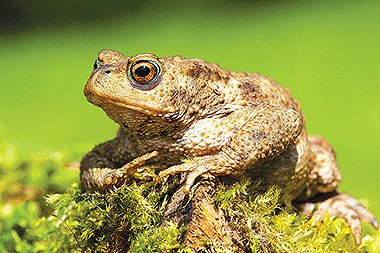February Sussex Wildlife Trust: Toad-in-the-hole
February 1st, 2024 How did that toad get inside that rock?
How did that toad get inside that rock?Once upon a time, the British people were divided. Impassioned debates raged throughout the land, truth and common sense became distorted, and the public rose up and demanded an answer. How did that toad get inside that rock?
In 1898, two burly workmen in a chalk quarry near Lewes cracked open a hollow chunk of flint. The solid rock, formed 85 million years ago, split open to reveal an airtight cavity at its core. To the quarrymen’s amazement, entombed within the ancient flint was a dead toad.
‘Toad-in-the-hole’ hysteria soon hit the headlines. It seemed like every month the newspapers reported how someone had split open a rock and found a toad inside. Some of these toads had already croaked but others would inexplicably still be alive and hopping. The Victorian world was thrown into theological and philosophical panic. Clergymen preached that the Creator had placed the eternal amphibians in rocks at the dawn of time. Subscribers to Darwin’s new theory of evolution were perplexed. Charles Dickens wrote of his bewilderment, while others believed it was simply sorcery. Scientists began burying living toads in sealed boxes to investigate the unfortunate animal’s longevity.
The Lewes toad of 1898 is the world’s only surviving artefact of the entombed toad craze. It now resides in Brighton’s incredible Booth Museum of Natural History – one of my favourite places in the whole world. Amongst the many awe-inspiring exhibits at The Booth, you’ll find a special cabinet dedicated to curiosities. In it, lying reverentially on a bed of maroon felt, there is ‘Probably the most famous toad in the world’. Admittedly when it comes to world-famous toads it’s not a particularly crowded field, with only Toad of Toad Hall to contest the title. Alongside the original oval of cleft flint sits the shrivelled body of the infamous amphibian. The whole surreal exhibit is like a Kinder Surprise designed by Hieronymus Bosch.
But this cracked up flint isn’t all it’s cracked up to be. The Lewes toad was originally presented to the Brighton and Hove Natural History and Philosophical Society by Charles Dawson. That’s the same Charles Dawson who would soon be sticking some Orangutan teeth on a human skull and declaring he had discovered the ‘missing link’ at Piltdown, near Uckfield.
In 1953, Dawson would be unmasked as a fraudster and the whole ‘toad-in-the-hole’ phenomenon would come crashing down, dismissed as poppycock.
By Michael Blencowe: Learning & Engagement Officer, Sussex Wildlife Trust.
Sussex Wildlife Trust is an independent registered charity caring for wildlife and habitats throughout Sussex. It’s easy to join: T: 01273 497532 or online at: www.sussexwildlifetrust.org.uk/join
Common Toad Dave Kilbey Sussex Wildlife Trust
In 1898, two burly workmen in a chalk quarry near Lewes cracked open a hollow chunk of flint. The solid rock, formed 85 million years ago, split open to reveal an airtight cavity at its core. To the quarrymen’s amazement, entombed within the ancient flint was a dead toad.
‘Toad-in-the-hole’ hysteria soon hit the headlines. It seemed like every month the newspapers reported how someone had split open a rock and found a toad inside. Some of these toads had already croaked but others would inexplicably still be alive and hopping. The Victorian world was thrown into theological and philosophical panic. Clergymen preached that the Creator had placed the eternal amphibians in rocks at the dawn of time. Subscribers to Darwin’s new theory of evolution were perplexed. Charles Dickens wrote of his bewilderment, while others believed it was simply sorcery. Scientists began burying living toads in sealed boxes to investigate the unfortunate animal’s longevity.
The Lewes toad of 1898 is the world’s only surviving artefact of the entombed toad craze. It now resides in Brighton’s incredible Booth Museum of Natural History – one of my favourite places in the whole world. Amongst the many awe-inspiring exhibits at The Booth, you’ll find a special cabinet dedicated to curiosities. In it, lying reverentially on a bed of maroon felt, there is ‘Probably the most famous toad in the world’. Admittedly when it comes to world-famous toads it’s not a particularly crowded field, with only Toad of Toad Hall to contest the title. Alongside the original oval of cleft flint sits the shrivelled body of the infamous amphibian. The whole surreal exhibit is like a Kinder Surprise designed by Hieronymus Bosch.
But this cracked up flint isn’t all it’s cracked up to be. The Lewes toad was originally presented to the Brighton and Hove Natural History and Philosophical Society by Charles Dawson. That’s the same Charles Dawson who would soon be sticking some Orangutan teeth on a human skull and declaring he had discovered the ‘missing link’ at Piltdown, near Uckfield.
In 1953, Dawson would be unmasked as a fraudster and the whole ‘toad-in-the-hole’ phenomenon would come crashing down, dismissed as poppycock.
By Michael Blencowe: Learning & Engagement Officer, Sussex Wildlife Trust.
Sussex Wildlife Trust is an independent registered charity caring for wildlife and habitats throughout Sussex. It’s easy to join: T: 01273 497532 or online at: www.sussexwildlifetrust.org.uk/join
Common Toad Dave Kilbey Sussex Wildlife Trust
Comments (0)
No comments have been submitted yet.Why not be the first to send us your thoughts
Leave A Comment
Thank you for your comments, they will appear shortly once approved.
Recent Posts
Have You Seen...






